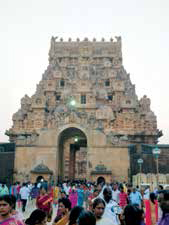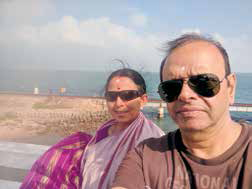India holds treasures everywhere, South, North, East and West and we would be well served to introduce our families to our own Indian traditions and cultures even as we continue to take them to foreign lands. Here’s a connoisseur’s view
 Grand entrance of the Tanjore Temple
Grand entrance of the Tanjore TempleIn the previous column, we had talked about the author’s whirlwind year-end trip to seven temple towns in Tamil Nadu and mentioned the attractions of Kanchipuram and Vellore. In this article we cover the other five.
The third stop on our tour was Tiruvannamalai. Dedicated to Lord Shiva in the name of Annamalai and his consort Parvati in the name of Unnamalai, this temple is gigantic and marvellous. The Magizhamb tree and the ‘wishing Vinayaka’ seated underneath the tree, Kartikeya shrine dedicated in memory of Arunagirinathar, a saint poet, Padala Lingam shrine worshipped by Ramana Maharshi and the Shiva Padam shrine are some of the noteworthy places inside the spacious temple. Shiva is worshipped in the form of fire at this temple. The hill behind the temple is lit with one lakh and eight lamps during the month of Karthikai, which is truly a wonderful sight and experience. The doorways of the temple are engraved with fine Bharatanatyam poses depicting the richness of the art form practised in the yesteryear.
The next stop was Tiruchirappalli or Trichy, an ancient town ruled by several dynasties with the first church being constructed by the Dutch during the Chola regime in 700 AD! The Ucchi Pillayar Temple dedicated to Lord Ganesha is atop a rock and you can have the sight of this temple from everywhere in the city. The climb to the top takes around half an hour. The temple complex also has beautiful shrines dedicated to Lord Shiva and Parvati and in the evening hours we managed to get the sunset view as well as the full view of the entire city.
The other major attraction is Srirangam, one of the 108 main abodes of Lord Vishnu. Srirangam is a sprawling temple complex, which has several shrines within, each of which are well preserved thanks to the regular repair and uplift work that is carried out. The main Gopuram called Rajagopuram is the tallest of its kind in Asia and has intricate carvings on it. Lord Vishnu has assumed the Anantasayana or the sleeping posture with Mahalakshmi beside him. There is a dedicated shrine for the revered Vaishnavite saint Ramanuja apart from one for a Muslim princess who loved the idol of Ranganathar, the main deity of the temple.
The Ucchi Pillayar Temple dedicated to Lord Ganesha is atop a rock and you can have the sight of this temple from everywhere in the city

Tanjore or Thanjavur, our next temple stop boasts of the Big Temple—dedicated to Brihadeeswarar. This is a World Heritage complex and is an excellent example of Chola patronage for temples. Built around 1000 years ago, the temple has also received the patronage of the Vijayanagar rulers and the Maratha kings. The Nandi or the bull in front of the main deity adds beauty to the temple which has several inscriptions which describe the methods of administration and upkeep of the temple.
The next stop was Madurai, with its cynosure being the Meenakshi Amman Temple, which is around 3,600 years old! The sculpture and the architecture are breathtaking and it is great to see Temple Museum attached to the temple with beautiful exhibits. Tamil is an ancient language, which has been in use for several centuries and Madurai is considered the mecca for Tamil literature, particularly belonging to the Sangam period. The richness of Tamil language attracted a young Japanese woman to learn the language, speak fluently in Tamil and even have a traditional Tamil wedding at the temple! Visitors to Madurai cannot return home without tasting the local drink Jigarthanda, introduced to the city during the Nayakkar rule by the Muslim traders and buying handloom sarees Chinnalam pattu and Sungudi.
Rameshwaram was our last stop on this trip—the tip of Rameshwaram-Dhanushkodi at the edge of Bay of Bengal is only a few kilometres away from the Sri Lankan coast. The town is famous for the Shiva temple where the Shiv Lingam was worshiped by Lord Rama. A drive around Dhanushkodi makes the Rameshwaram trip complete, which is just a few dozen kilometres form the Sri Lankan shore line and the place from which the Vanara Sena in the Ramayan started the bridge of rocks to Lankan shores that would see Rama marching to the island nation and bringing his wife Sita back from the clutches of Ravana.
For a person like Uma, who has grown up in the folklore of Tamil Nadu, this visit was a refresher course into the culture and religious traditions of her home state. And for Ganesh, who was born and raised in Bengal and Bihar, this is one of many opportunities over the years to understand the traditions and culture which he missed while growing up. Our friends who accompanied us on this trip were born and raised in Delhi but enjoyed the trip as much as we did. Which just goes to show that India holds treasures everywhere, South, North, East and West and we would be well served to introduce our families to our own Indian traditions and culture even as we continue to take them to foreign lands!
Ganesh Natarajan